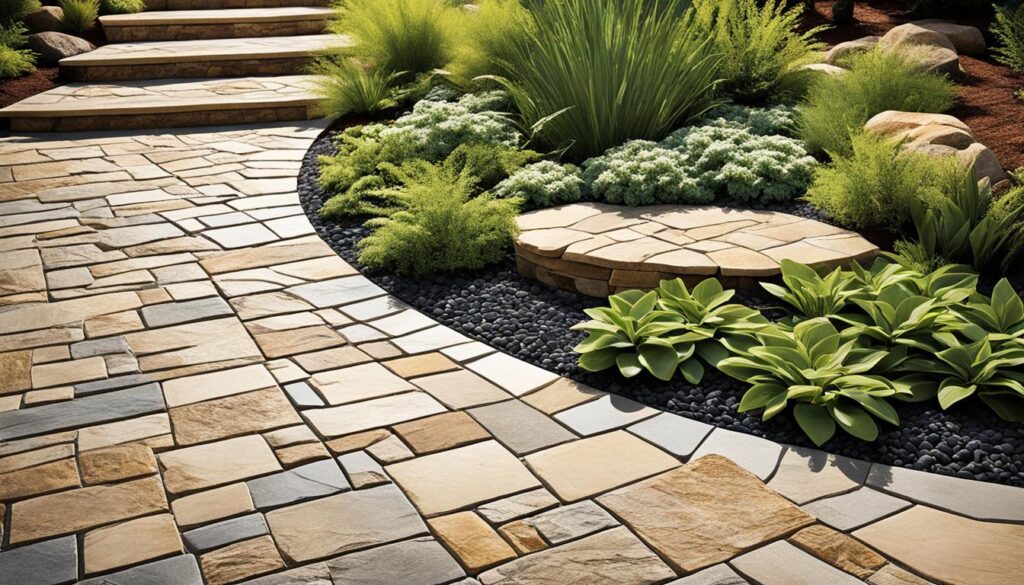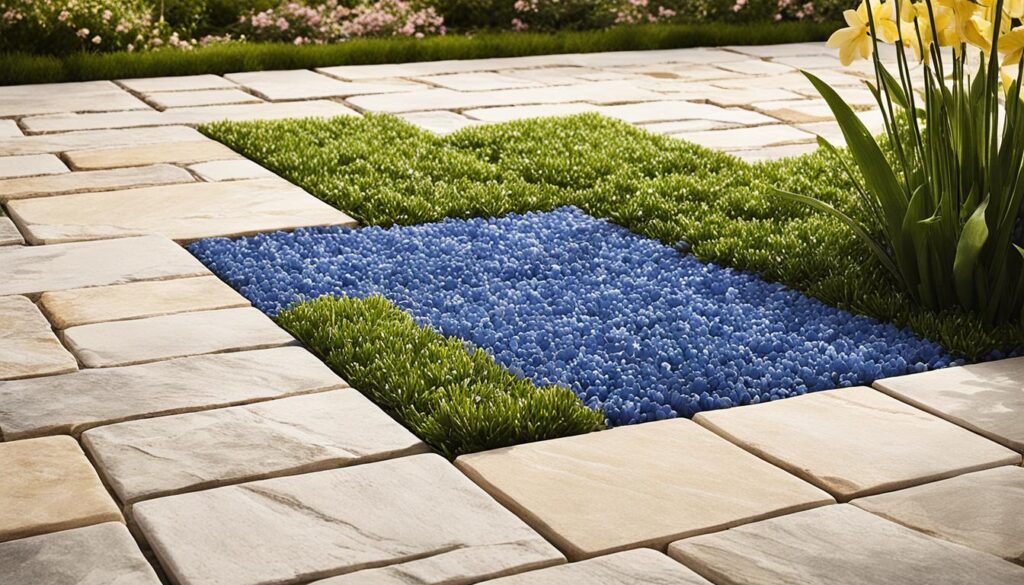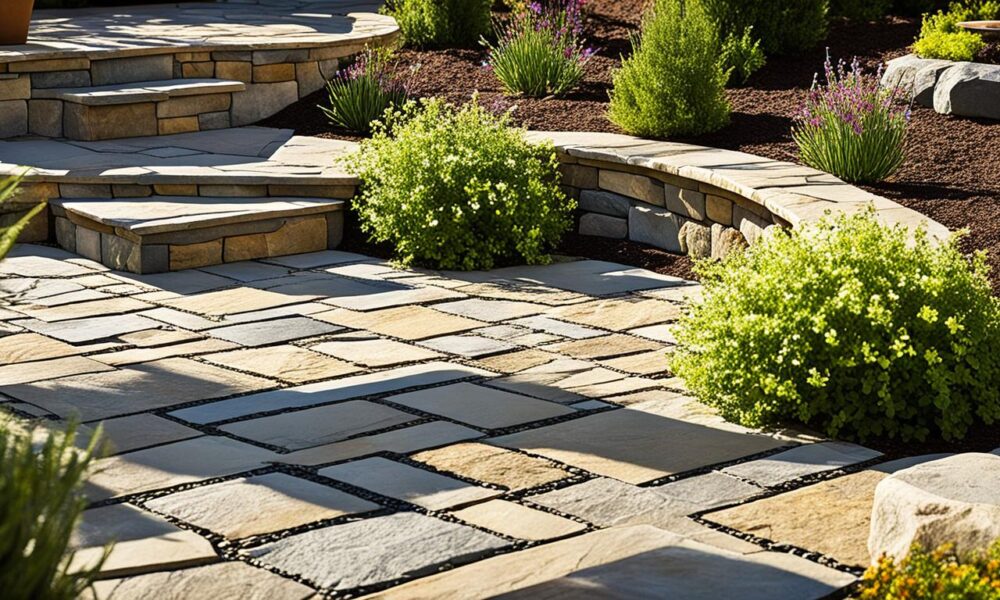Natural Stone Flooring Ideas Outdoor: Top Picks
When it comes to creating a stunning outdoor space, natural stone flooring is a top choice. Not only does it add beauty and elegance to patios, pool areas, and other outdoor living spaces, but it also offers durability and easy maintenance. One excellent option for outdoor stone flooring is Cantera Stone, a volcanic stone quarried in Mexico. Cantera stone tiles come in various patterns and colors, allowing you to create a unique design that complements your outdoor area.
Cantera stone is known for its weather resistance, making it ideal for outdoor use. It can withstand the elements and maintain its beauty for years to come. Additionally, Cantera stone is non-slip, ensuring safety in high-traffic areas such as patios and pool decks. Cleaning and maintaining Cantera stone flooring is a breeze, requiring only regular sweeping or hosing off debris.
One of the distinct advantages of Cantera stone is its versatility. It blends seamlessly with different architectural styles, allowing you to match it with your home’s aesthetics. Whether you prefer a modern, minimalist look or a rustic, traditional vibe, Cantera stone flooring can be customized to suit your preferences.
Key Takeaways:
- Cantera Stone is a popular choice for outdoor flooring due to its durability and beauty.
- It is weather-resistant, non-slip, and easy to clean and maintain.
- Cantera stone comes in various patterns and colors, allowing you to create a personalized outdoor space.
- It blends well with different architectural styles.
- Cantera stone offers a durable and elegant solution for outdoor flooring.
Why Choose Cantera Stone for Outdoor Patios?
Cantera Stone is a popular choice for outdoor patios due to its exceptional qualities and versatility. As one of the best natural stones for outdoor flooring, Cantera offers a combination of durability, beauty, and ease of maintenance that makes it an ideal option for outdoor spaces.
With its ability to withstand all four seasons, Cantera Stone is designed specifically for outdoor use. Whether it’s scorching summers or freezing winters, Cantera Stone can handle it all, making it a reliable choice for patios that need to endure harsh weather conditions.
One of the standout features of Cantera Stone is its non-slip texture. This makes it perfect for patios, porches, and pool areas, where safety is paramount. You can enjoy your outdoor space without worrying about accidental slips or falls.
Maintaining Cantera Stone is a breeze. Unlike some other flooring materials, it can be easily cleaned with a power washer or hose. This makes it convenient for busy homeowners who want an outdoor flooring option that requires minimal effort to keep looking its best.
When it comes to customization, Cantera Stone offers a wide variety of colors and patterns to choose from. This allows you to create a unique and personalized outdoor space that reflects your style and preferences. Whether you prefer a traditional look or a more contemporary design, Cantera Stone has options to suit every taste.
To illustrate the versatility and beauty of Cantera Stone, consider the following table:
| Color | Pattern | Usage |
|---|---|---|
| Terracotta | Herringbone | Patio |
| Gray | Random Ashlar | Pool area |
| Beige | Versailles | Porch |
As you can see, Cantera Stone provides a wide range of options for creating a stunning outdoor living space.
“Cantera Stone is the perfect choice for outdoor patios due to its durability, versatility, and easy maintenance.”
Types of Stone for Outdoor Patios
When designing an outdoor patio, selecting the right type of natural stone is essential to creating a beautiful and durable space. Here are some popular options to consider:
1. Bluestone
Bluestone is a top choice for outdoor patios due to its exceptional durability and weather resistance. It is known for its subtle blue-gray hues, which add a touch of elegance to any outdoor space.
2. Limestone
Limestone is a versatile stone that offers reliability and an elegant appearance. With a wide range of colors and textures available, it can be customized to suit various patio designs.
3. Brownstone
For those seeking a rustic look that complements natural surroundings, brownstone is an excellent option. Its warm earth tones and unique patterns bring a touch of charm to outdoor patios.
4. Sandstone
Sandstone is a visually striking choice with its natural variations in color and texture. It is especially well-suited for water features, as it adds a beautiful element of visual interest.
5. Sahara Granite
If you’re considering incorporating water features into your patio design, Sahara Granite is a great choice. Its unique blend of warm earth tones and intricate patterns create a stunning focal point.
6. Pea Gravel
For a more affordable alternative to stone slabs and pavers, pea gravel can be an excellent option. Its small, smooth stones create a visually appealing and comfortable outdoor flooring surface.
Each type of stone offers its own unique qualities and can greatly enhance the beauty and functionality of your outdoor patio. Consider your desired aesthetic, budget, and maintenance requirements when selecting the best natural stone for your outdoor flooring needs.
| Stone Type | Main Features |
|---|---|
| Bluestone | Durable and weather-resistant; elegant blue-gray hues |
| Limestone | Versatile; reliable and elegant; wide range of colors and textures |
| Brownstone | Rustic look; warm earth tones; unique patterns |
| Sandstone | Visually striking; natural variations in color and texture; perfect for water features |
| Sahara Granite | Blend of warm earth tones; intricate patterns; ideal for patios with water features |
| Pea Gravel | Affordable alternative; visually appealing and comfortable surface |
Choosing the Best Stone for Your Patio
When it comes to selecting the perfect stone for your patio, there are several factors to consider. It’s important to find a stone that not only aligns with your personal style but also enhances the overall aesthetic of your home and backyard. Whether you’re looking for outdoor stone paving ideas or outdoor stone tile ideas, the right choice of stone can make a significant impact on your outdoor living space.
Firstly, durability is a crucial aspect to keep in mind. Since your patio is exposed to the elements, you’ll want a stone that can withstand various weather conditions and last for years to come. Opting for a durable stone will ensure that your patio remains beautiful and functional for a long time.
Another important consideration is weather resistance. Look for a stone that is specifically designed to withstand the climatic conditions of your area. This will help prevent issues such as fading, cracking, or damage due to extreme temperatures or moisture.
Maintenance requirements are also essential. Some stones may require regular sealing or specialized cleaning, while others are relatively low-maintenance. Consider your available time and willingness to dedicate time to the upkeep of your patio when making your decision.
Think about the style you want to achieve with your patio. Do you prefer a traditional or a modern look? Consider how different stones can contribute to the overall design and ambiance of your outdoor space. If you’re interested in incorporating water features or other decorative elements, choose a stone that complements these additions.
Lastly, budget plays a significant role in the decision-making process. Some stones may be more expensive than others, so it’s essential to set a budget and stick to it. However, it’s important to remember that investing in a high-quality stone will ultimately save you money in the long run, as durable stones require fewer repairs and replacements.
Consulting with a professional can provide valuable insight and guidance when choosing the best stone for your patio. They can help you navigate through the various options and recommend the most suitable stone based on your specific needs and preferences.
Comparison of Different Stone Types for Patios
| Stone Type | Durability | Weather Resistance | Maintenance | Style | Price Range |
|---|---|---|---|---|---|
| Cantera Stone | High | Excellent | Low | Versatile | Medium |
| Bluestone | High | Good | Medium | Elegant | High |
| Limestone | Medium-High | Excellent | Low | Classic | Medium |
| Brownstone | Medium | Good | Low | Rustic | Medium |
| Sandstone | Medium | Good | Medium | Attractive | Low |
| Sahara Granite | High | Excellent | Medium | Stylish | High |
| Pea Gravel | Low | Good | Medium | Cost-effective | Low |
Note: Prices are approximate and may vary based on location and supplier.
Creating a Unique Outdoor Space with Stone
Stone outdoor floor tiles offer endless possibilities for creating a unique and stylish outdoor space. By utilizing various shapes, sizes, and colors of stone tiles, you can design different patterns and create a personalized look that matches the personality of your outdoor area. Whether you prefer a bold and vibrant aesthetic or a more subdued and sophisticated style, there are backyard stone flooring designs and outdoor stone paving ideas to suit every taste.
One way to add visual interest to your stone tile patio is by using decorative stone wall tiles. These can be incorporated into the design to create stunning accent walls or feature areas that make a statement in your outdoor space. The combination of floor and wall tiles can create a cohesive look and add depth and texture to the overall design.
When it comes to creating patterns with stone outdoor floor tiles, you have countless options. Mix and match different colors of tiles to create contrast and highlight specific areas. Alternatively, you can choose a solid-colored tile for a more classic and sophisticated look. Consider using different shapes and sizes of tiles to add variety and create a visually dynamic space.
Additionally, don’t forget to incorporate decorative stone features that complement your stone tile patio. This can include stone accents, such as benches, planters, or statues, that enhance the overall aesthetic and create a focal point in your outdoor area. Coordinating these decorative elements with your stone tile patio ensures a harmonious and cohesive design.
Other Uses for Stone in Outdoor Spaces
Stone outdoor floor tiles are not just limited to flooring. They can be used in various other ways to enhance the beauty of your outdoor space. Consider using stone for columns, fountains, sculptures, figurines, fireplaces, and stone surrounds. Outdoor stone features such as fountains, sculptures, and fireplaces can add a touch of luxury and elegance to your backyard. Stone pool coping is a great addition to swimming pools, and stone planters can bring a natural and organic feel to your outdoor area.
The versatility of stone allows you to create a cohesive and visually appealing outdoor space. Whether you want to create a serene garden retreat or an entertaining area for hosting guests, outdoor stone elements can elevate the overall aesthetic of your outdoor space. Consider incorporating stone into pergola columns, patio walls, and even stone steps to add beauty and functionality to your outdoor living area.
Advantages of Stone Elements in Outdoor Spaces
There are several advantages to incorporating stone elements into your outdoor space:
- Enhanced aesthetic appeal: Stone features can add a touch of elegance and sophistication to your outdoor area, creating a visually stunning space.
- Durability: Natural stone is known for its durability and can withstand harsh weather conditions, ensuring long-lasting beauty.
- Low maintenance: Stone requires minimal maintenance, making it a practical choice for outdoor areas. Regular cleaning and occasional sealing are usually sufficient to keep stone elements looking their best.
- Versatility: Stone comes in a variety of shapes, sizes, and colors, allowing for endless design possibilities. Whether you prefer a modern or traditional look, there is a stone style to suit your taste.
- Increased property value: The addition of stone elements can enhance the value of your home, making it a worthwhile investment.
By incorporating stone elements into your outdoor space, you can create a truly unique and inviting area that reflects your personal style and complements your landscaping. Whether you want to create a cozy fireplace area or a stunning water feature, stone can bring your vision to life.
“Stone features in outdoor spaces add character, elegance, and a sense of permanence to the overall design.” – Landscape Architect
To visualize how stone elements can transform your outdoor space, take a look at the image below:
As you can see, the stone fountain serves as a focal point, adding both beauty and tranquility to the outdoor area. The surrounding stone tiles complement the fountain, tying the entire space together.
Whether you choose to incorporate stone flooring, columns, fountains, or other elements, the possibilities are endless. Let your creativity flow and create an outdoor space that truly reflects your style and enhances the beauty of your home.
| Stone Element | Advantages |
|---|---|
| Stone columns | Enhanced architectural detail, durability, timeless elegance |
| Stone fountains | Tranquility, focal point, adds a touch of luxury |
| Stone sculptures | Artistic expression, unique focal point, adds visual interest |
| Stone fireplaces | Cozy ambiance, warmth, perfect for outdoor entertaining |
| Stone surrounds | Seamless integration with outdoor features, enhances aesthetic appeal |
Pros and Cons of Different Outdoor Flooring Materials
When it comes to outdoor flooring, there are various materials to choose from. Each material has its own set of advantages and disadvantages that should be considered before making a decision. Here is a list of pros and cons for different outdoor flooring materials:
Moss and Other Ground Covers
If you’re looking for a nature-oriented look, moss and other ground covers can provide a beautiful and organic feel to your outdoor space. However, it’s important to note that these materials require specific growing conditions and may not thrive in all environments.
Mulch
Mulch is a popular choice for outdoor flooring due to its affordability and ease of installation. It can create a clean and natural look while also providing some level of cushioning. However, mulch needs periodic replenishment as it can decompose over time.
Pea Gravel
Pea gravel is another cost-effective option for outdoor flooring. It is easy to maintain and provides good drainage. However, it may not be suitable for high traffic areas as the gravel can shift and create an uneven surface.
Wood
Wooden flooring offers a versatile and customizable option for outdoor spaces. It provides a warm and natural aesthetic that complements various architectural styles. However, wood requires regular maintenance, including staining or sealing, to protect it from weather damage and maintain its appearance.
Concrete
Concrete is known for its durability and longevity. It can withstand heavy foot traffic and is resistant to weather conditions. However, concrete is prone to cracking, and regular sealing is required to prevent moisture damage and maintain its appearance.
Stone
Stone flooring is a durable and robust option for outdoor spaces. It comes in various options, such as limestone, bluestone, and cantera stone, providing different colors and patterns to choose from. Stone is resistant to weather conditions and requires minimal maintenance. However, it can be relatively expensive compared to other materials.
It’s essential to consider your specific needs and preferences when selecting outdoor flooring materials. Think about factors such as aesthetics, desired level of maintenance, budget, and durability to make an informed decision that suits your outdoor space and lifestyle.

| Outdoor Flooring Material | Pros | Cons |
|---|---|---|
| Moss and Other Ground Covers | Nature-oriented look | Requires specific growing conditions |
| Mulch | Affordable and easy to install | Needs periodic replenishment |
| Pea Gravel | Cheap and easy to maintain | May not be suitable for high traffic areas |
| Wood | Versatile and customizable | Requires regular maintenance |
| Concrete | Durable and resistant to weather conditions | Proned to cracking and requires sealing |
| Stone | Durable and minimal maintenance | Relatively expensive |
Tips for Choosing and Installing Outdoor Flooring
When it comes to selecting and installing outdoor flooring, there are several important factors to consider. Whether you’re designing a beautiful backyard patio or revamping your outdoor living space, these tips will help you make informed decisions and ensure a seamless installation process.
1. Consider Style and Texture
Begin by determining the style and texture you desire for your outdoor space. Are you looking for a rustic, natural look or a more modern, sleek aesthetic? Consider the overall theme and ambiance of your outdoor area and choose the appropriate type of stone or material that aligns with your vision.
2. Plan the Layout and Design
Before beginning the installation process, take the time to plan the layout and design of your outdoor flooring. Consider the size and shape of the area, as well as any existing landscaping features. Ensure that the flooring fits seamlessly with the surrounding landscape and creates a cohesive and visually appealing outdoor space.
3. Preparation is Key
To ensure a successful installation, it’s crucial to prepare the area properly. Clear away any debris or vegetation, and level the surface if necessary. A clean and level foundation will provide a stable base for your outdoor flooring, ensuring its longevity and durability.
4. Follow Proper Installation Techniques
Each type of stone or material may have specific installation techniques and guidelines. It’s important to familiarize yourself with the recommended methods to ensure a proper and secure installation. Follow the manufacturer’s instructions and consult with professionals if needed to achieve the best results.
5. Consider Drainage and Maintenance
When choosing outdoor flooring, it’s essential to consider factors such as drainage and maintenance requirements. Ensure that the flooring allows for proper water runoff to prevent any potential water damage. Additionally, consider the maintenance needs of the chosen material and your willingness to invest time and effort in its upkeep.
6. Prioritize Durability
Outdoor flooring is exposed to various weather conditions and foot traffic. It’s crucial to select a durable material that can withstand these challenges. Choose a stone or material that is known for its durability and ability to withstand the elements, ensuring that your outdoor flooring will stand the test of time.
7. Consider Professional Installation
If you’re unsure about the installation process or lack the necessary skills and tools, it’s always a good idea to hire a professional. They have the expertise and experience to ensure a proper and efficient installation, giving you peace of mind and minimizing any potential issues.
8. Compare Options to Make an Informed Choice
Before making a final decision, compare different outdoor flooring options such as stone tiles, pavers, or wood. Evaluate their pros and cons, considering factors such as cost, maintenance, and aesthetic appeal. By making an informed choice, you can select the best outdoor flooring that suits your preferences and fits within your budget.
By following these tips, you can confidently navigate the process of choosing and installing outdoor flooring. Whether you opt for beautiful stone tiles or a different material, your outdoor space will be transformed into a stunning and functional area that you can enjoy for years to come.
Maintaining and Caring for Outdoor Stone Flooring
Outdoor stone flooring requires regular maintenance and care to keep it looking its best. By following some simple cleaning and maintenance practices, you can ensure that your outdoor stone flooring retains its durability and aesthetic appeal for years to come.
Cleaning and Sweeping
Regularly sweeping or hosing off your outdoor stone flooring is an important step in preventing the buildup of debris and dirt. This will help maintain the natural beauty and texture of the stone tiles. Consider using a broom with soft bristles or a garden hose to gently remove any loose dirt or leaves from the surface.
Tackling Tough Stains
If you encounter tough stains or mud spots on your outdoor stone flooring, don’t worry. A power washer or hose can be a handy tool for removing stubborn stains. Adjust the water pressure accordingly to avoid damaging the stone surface, and always follow the manufacturer’s guidelines for using a power washer.
Applying a Quality Sealer
To provide UV protection and prevent fading, applying a quality sealer to your outdoor stone flooring is essential. This protective layer will help maintain the color and integrity of the stone tiles, minimizing the effects of sun exposure and weathering. Consult the manufacturer’s instructions to choose the right sealer for your specific type of stone.
Preventing Efflorescence
Efflorescence, a white powdery deposit on the surface of the stone, can occur due to moisture and mineral deposits. Consider using a waterproofing membrane on the concrete subfloor beneath your outdoor stone flooring to prevent efflorescence. This membrane acts as a barrier, blocking moisture from reaching the stone tiles and reducing the risk of efflorescence formation.
Following Manufacturer’s Instructions
Every type of stone has its unique cleaning and maintenance requirements. To ensure proper care for your outdoor stone flooring, always follow the manufacturer’s instructions. These instructions will provide specific guidelines on cleaning agents, sealants, and other maintenance practices to keep your stone tiles in pristine condition.
With proper maintenance and care, your outdoor stone flooring can withstand the test of time and continue to enhance the beauty of your outdoor space. By incorporating these maintenance practices into your routine, you can enjoy the durability, elegance, and long-lasting appeal of your outdoor stone flooring for many years to come.

Benefits of Natural Stone Flooring for Outdoor Spaces
Natural stone flooring offers several benefits for outdoor spaces. Its durability and ability to withstand all weather conditions make it an excellent choice for outdoor flooring. With its timeless and elegant look, natural stone enhances the beauty of any outdoor area, creating a sophisticated and inviting atmosphere.
One of the standout features of natural stone is its versatility. It can be used for various applications in outdoor spaces such as patios, pool areas, and walkways. Whether you prefer a classic, modern, or rustic design, natural stone offers a wide range of colors, patterns, and sizes to suit your style and preferences. This versatility allows for endless design possibilities, enabling you to create a truly unique and personalized outdoor space.
Another advantage of natural stone flooring is its sustainability. As a natural material, it is an eco-friendly choice. By opting for natural stone, you contribute to the preservation of the environment. Additionally, the durability of natural stone means that it can withstand the test of time, reducing the need for frequent replacements and minimizing waste.
Natural stone flooring adds value to your outdoor space. Its elegant appearance and durability make it a desirable feature for potential homebuyers. Whether you are planning to sell your property in the future or simply want to enhance the overall aesthetic and value of your home, natural stone flooring is a worthwhile investment.
Benefits of Natural Stone Flooring for Outdoor Spaces:
- Durable and able to withstand all weather conditions
- Timeless and elegant look that enhances the beauty of outdoor areas
- Versatile and suitable for various applications
- Wide range of colors, patterns, and sizes for endless design possibilities
- Sustainable and eco-friendly choice
- Adds value to your outdoor space and home
| Benefits | Description |
|---|---|
| Durability | Natural stone is able to withstand all weather conditions, making it a durable choice for outdoor flooring. |
| Timeless Look | The elegant and classic appearance of natural stone enhances the beauty of any outdoor space, creating a timeless look. |
| Versatility | Natural stone can be used for various outdoor applications such as patios, pool areas, and walkways. |
| Design Possibilities | With a wide range of colors, patterns, and sizes available, natural stone offers endless design possibilities for your outdoor space. |
| Sustainability | Choosing natural stone is an eco-friendly option as it is a natural material that contributes to environmental preservation. |
| Added Value | Natural stone flooring adds value to your outdoor space and home, making it an attractive feature for potential buyers. |
With its durability, timeless look, versatility, sustainability, and added value, natural stone flooring is an excellent choice for transforming your outdoor space into a beautiful and inviting oasis.
Considerations for Designing Outdoor Stone Flooring
When it comes to designing outdoor stone flooring, there are a few key considerations that can help you create a beautiful and functional space. From the overall aesthetic to the size and shape of the area, these factors play an important role in determining the right stone tiles for your outdoor flooring project.
1. Complement the Aesthetic
Incorporating stone colors and patterns that complement the overall aesthetic of your outdoor space is crucial. Whether you’re aiming for a modern, rustic, or traditional look, choosing stone tiles that align with your design vision will create a cohesive and visually appealing atmosphere.
2. Size and Shape of the Area
The size and shape of the area where you plan to install outdoor stone flooring should also be taken into account. Larger tiles may work well in larger open spaces, while smaller or irregularly shaped tiles can add visual interest in more confined areas.
3. Function and Usage
Consider the function and usage of the outdoor space when selecting stone tiles. If it will be a high-traffic area, choose a durable stone that can withstand heavy footfall. If water features or outdoor cooking areas are involved, opt for a stone that is non-slip and resistant to moisture.
4. Maintenance and Durability
Think about the maintenance requirements and durability of the stone you choose. Some stones may require regular sealing or special care to maintain their appearance over time. Consider your willingness and ability to invest in ongoing maintenance when making your selection.
By carefully considering these factors and getting creative with different patterns and designs, you can create a unique and personalized outdoor space that showcases the natural beauty of stone flooring.
Conclusion
When it comes to enhancing your outdoor space, natural stone flooring provides a wide array of options and possibilities. From the timeless elegance of Cantera Stone to the durability of bluestone and limestone, there are various types of natural stones that can transform your patio, walkway, or garden into a stunning and inviting space. Each stone offers unique qualities and benefits, allowing you to create a personalized outdoor flooring that reflects your style and complements your home and backyard.
To select the best stone flooring for your outdoor space, consider the overall aesthetic you want to achieve and the specific requirements of your outdoor area. Take into account factors such as durability, weather resistance, and maintenance needs. With proper planning, installation, and maintenance, natural stone flooring will not only enhance the beauty of your outdoor space, but also provide a durable and long-lasting solution for your patio or walkway.
Whether you choose Cantera Stone for its versatility or opt for other natural stones like bluestone or limestone, natural stone flooring is sure to elevate the appeal of your outdoor area. So take advantage of the wide range of natural stone flooring ideas for your outdoor space, and transform your patio or garden into an impressive and inviting oasis that will be the envy of your friends and neighbors.



